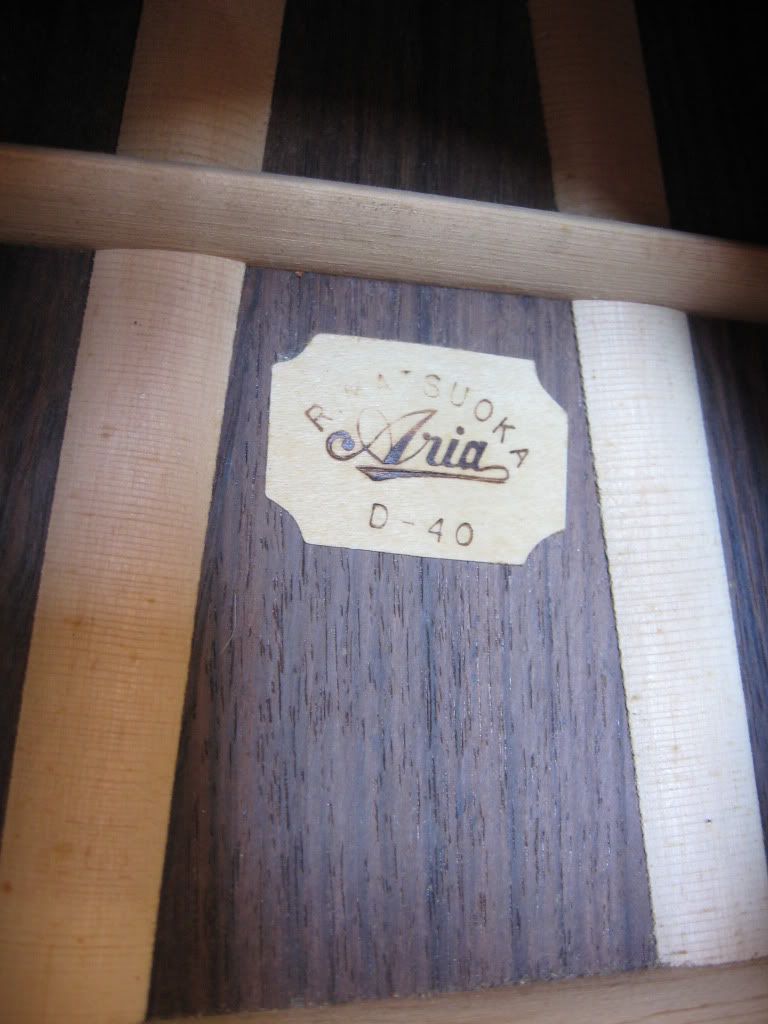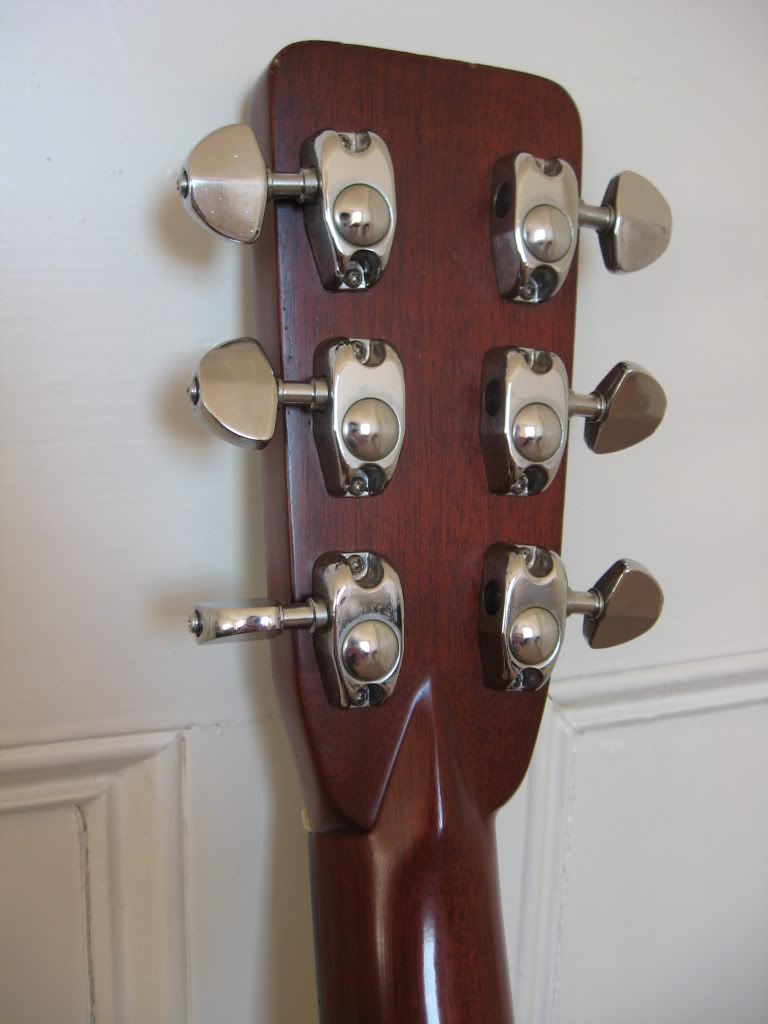Everyone reading this will of heard of Aria, and may of had the same outlook as me - nice enough but not great. You've seen them in the shop and they don't really compare to that Seagull or Simon & Patrick at about the same price. Most nowadays are made in China or Indonesia, with any of the top models in the current line up rarely brought in by shops outside of native Japan. Interestingly enough, their current line features the AD range, self-conceeding their pinnacle era of craft was the 70's and attempting to rekindle the past. Few people i imagine recall those guitars, seeing as so few made it in Western markets. Indeed, here was another array of quality acoustics that eluded the West and triumphed in their home market. Thankfully old catalogues helped me uncover the rather fantastic past it had and steer me to my first Aria purchase.
Aria as we know it, actually started as Arai in the mid-60's. Like many other brands in Japan, the music scene at the time drove a whole new wave of instrument manufacturers and new factories to meet the damand the scene inspired. The earliest of these Arai's were primarily plywood construction copies of Martin's and Guilds, occasionally under the brand Diamond. Personally these are not a shade on what they went on to produce 5 years later. With the change from Arai to Aria, and switching to Matsumoku factories to construct their acoustic and some of the electric range of guitars, Aria began to offer real quality. I've mentioned Matsumoku before in the Westone entry, without mentioning Ryo Matsuoka, who was the head designer for Matsumoku. Matsuoka was a highly skilled luthier who went about constructing exceptional Martin copies under the Aria brand throughout the 70's. He also formed his own small company making nylon strung acoustics which are still made to this day. Indeed his name is synonmous with quality instruments for the past 30 years in Japan.
I have a few Arias from this era, but this entry is about my Aria D40, which was my first. As mentioned before, nomenclature is a useful guide. D stands for dreadnought, whilst 40 indicates it cost Y40,000 on it's release in 1973. Back in 1973, this was certainly not cheap in Japan, but certainly much cheaper than a Martin would cost. The D range was their flagship range, based purely on the Martin guitars of the same title. Everything about this D40 is Martin-esque. The diamond headstock joint, the 3-piece back inspired from the Martin D35, the headstock logo Aria Dreadnought in the same font and italic as the Martin & Co logo. This is very easily mistaken for a Martin guitar, and i don't think that stops once you start playing it either. This is quite a heavy guitar, with really fine construction, featuring a solid german spruce top, coral rosewood sides, and a three peice brazilian-indian-brazilian rosewood back, with intricate mosiac inlays separating the woodtypes. The neck is a chunky v shape, again identical to Martin guitars of the time, with quite unique tuners. I don't know if these are in-house Aria tuners or Gotoh/Schaller, but they are amongst the best i have used. Rock solid tuning. I am tempted to lower the action a little, shave down the bone bridge, as the action is a little high at 8mm at the 12th fret, but it plays very well. If anything, the clearance really allows this one to sing; it really is full bodied and complex, with excellent balance - not so much the booming bass of the Westone, it has a lot of mids in its mix aswell. What continually suprises me is how well these guitars hold up. This is now 37 years old, and looks flawless. The top has faded a little, but it is completely scratch free, and the internal bracing and glued joints/saddle are completely solid. Attention to detail and the amount of hand-craftmanship really stands testament when playing this guitar. I will share a video and/or sound file of this in a later entry (once i sort out compressing the videos) , but here are the usual photos to enjoy until then:



Rest of the photos are here
Have you had any experience with the Aria Pro II acoustics? I've got one that looks like a PW-18 but is labeled AS-30. I haven't been able to find any reference to this particlar model number. It's definitely Matsumoku made since I got it used around 1986.
ReplyDeleteI have, i owned a Aria Pro II PW-56 acoustic, which i have yet to write about on here. It was a beautiful model which i sold on to a good fellow down in England.
DeletePW signified their Professional Series models - i used to have a link to the information page on these guitars, as i know how hard it is to find info on these models. They were generally made as high end acoutsics for the US market, made by Matsumoku. The PW56 i had was a handmade model, as was the top of the range PW65, which had the vine inlay down the fingerboard. I can only guess that the AS-30 is the Japanese model code, which following their system, is 30,000 Yen in the mid 80s.
I'll need to get on with that entry here, but in the meantime, here are some links of mine you might find of interest.
Photos: http://s914.photobucket.com/albums/ac346/moonshiner82/Aria%20pro%20II%20PW56/
Video: http://www.youtube.com/watch?v=cjpP7hBcGKQ
Thank you for the reply. That PW56 is a real beauty. The Japanese nomenclature is something I haden't considered before. I bought the guitar in the US, but it was used, so I've no knowledge of its prior history. Also, it has a label without a serial on it. I was concerned that there might be something "funny" with it until I saw that your PW56 has the same arrangement. I was actually considering removing the label to see if it was covering anything until I saw your pictures! Anyway, I'm looking forward to your entry on the PW. Keep up your great work documenting these wonderful instruments!
DeleteI have had a D40 since 1978. Bought it off a friend in South Africa who didn't like the hard sound. It's mellowed. I play in a fiddle band of 50 plus musicians in Calgary and other band members keep asking me what it is as it sounds so good. The best guitar investment I ever made. It'd cost thousands to replace with a similar guitar.
ReplyDeleteHi, I just picked up an Aria 9412, a small body (14" lower bout) spruce & rosewood flat top. Well, it looks like Spruce & Rosewood, I can't find any real info on this model. I'm guessing early '70s, can you shed any light on this magnificent instrument? Thanks...
ReplyDeleteJerry
I have a Aria Pro ii PW 18. Any thoughts/info would be appreciated.
ReplyDeleteHi I'm trying to find out about my guitar. It's an aria. I'm told it's from japan 1976,and that it's a copy of a Martin d41. This seems correct as it looks exactly the same as a d41 apart from the neck doesn't have the raised v where it meets the headstock and the tuners are different. The label inside the sound hole reads, aria a division of aria and co inc, followed by a little sign with a guitar in the middle, model W420 japan. No serial number is present unless it's faded. It's also had another label on the bracing just inside the sound hole under the fingerboard, but only a small part of this remains and I can't make out what it says. I'm told it has Brazilian rosewood back an sides,Sitka spruce top,mahogany neck,ebony fingerboard with hexagon shape pearl inlays,abalone inlay around top and back binding and around the sound hole,large aria wrote in abalone vertical on headstock,tuners are excellent and would love to know who made them ? Please please can anyone help with more info or confirming any of the above. I love this guitar
ReplyDeleteHi I'm trying to find out about my guitar. It's an aria. I'm told it's from japan 1976,and that it's a copy of a Martin d41. This seems correct as it looks exactly the same as a d41 apart from the neck doesn't have the raised v where it meets the headstock and the tuners are different. The label inside the sound hole reads, aria a division of aria and co inc, followed by a little sign with a guitar in the middle, model W420 japan. No serial number is present unless it's faded. It's also had another label on the bracing just inside the sound hole under the fingerboard, but only a small part of this remains and I can't make out what it says. I'm told it has Brazilian rosewood back an sides,Sitka spruce top,mahogany neck,ebony fingerboard with hexagon shape pearl inlays,abalone inlay around top and back binding and around the sound hole,large aria wrote in abalone vertical on headstock,tuners are excellent and would love to know who made them ? Please please can anyone help with more info or confirming any of the above. I love this guitar
ReplyDeleteNotice that there are little holes or crevices throughout, or often course irregular surface textures. Acoustic Materials Cyprus
ReplyDeleteSuprize the d40 i have does not have a solid top its a two ply ....2/3 cedar top with a 1/3 ply ...I squared the sound hole to put a tornovoz in ....its still the best acoustic guitar I ever played 50+ I have pics if anyone interest
ReplyDelete